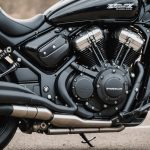Overview of Stator Functionality
The stator plays a crucial role in motorcycle electrical systems, particularly in models like the Kawasaki Vulcan S. It functions as a stationary component within the alternator, responsible for generating electricity. Here’s a breakdown of its key functions and importance in vehicle performance.
At the heart of the stator’s functionality is its ability to convert mechanical energy into electrical energy. This process begins when the motorcycle’s engine starts, causing the rotor to spin within the stator. As the rotor spins, it induces an electrical current in the stator’s coils through electromagnetic induction. This current is then used to charge the battery and power the motorcycle’s electrical systems, including lights, ignition, and other accessories.
Also to read : Ultimate Guide: How to Properly Apply Ceramic Coating for Paint Protection on Your Vespa LX150
Maintaining a functioning stator is critical for the smooth operation of the Kawasaki Vulcan S. A malfunctioning or damaged stator can lead to insufficient battery charging, causing potential issues like dimming lights or a failing ignition system. Regular checks and timely maintenance ensure that the stator continues to operate efficiently, providing reliable power to the motorcycle’s electrical systems and enhancing overall vehicle performance. Regular maintenance checks, like cleaning connectors and inspecting for wear or damage, are advisable to avoid unexpected breakdowns. This proactive maintenance is crucial for ensuring an enjoyable and trouble-free riding experience.
Symptoms of a Faulty Stator
A faulty stator can be the root cause behind several Kawasaki Vulcan S issues. Understanding these common signs is crucial for timely motorcycle troubleshooting and preventing further damage.
Have you seen this : Mastering Valve Timing Adjustments: A Comprehensive Guide for Your Yamaha YZF-R1
Firstly, one of the most prevalent symptoms is a weak or dead battery. As the stator’s role is to charge the battery, any problem in its functioning might lead to your battery losing charge quickly or failing altogether. If your motorcycle struggles to start or if the lights dim, consider these red flags.
Another significant indicator is engine misfires or stalling. When the stator does not supply adequate power, it can lead the engine to sputter or even cut out. This symptom not only hampers performance but poses safety risks, particularly if the issue strikes mid-ride.
Motorcyclists may also notice unusual noises from the engine. Sounds like whining or chirping can signal when the stator is beginning to fail. Pay attention to these auditory cues to diagnose issues early on.
Early detection is key in preventing more costly repairs. Address any faulty stator symptoms promptly to maintain the optimal performance of your Kawasaki Vulcan S. Proper motorcycle troubleshooting at the first sign of trouble can save both money and ensure a safer riding experience.
Step-by-Step Diagnostic Procedures
Diagnosing a faulty stator involves systematic inspection and methodical testing of motorcycle components. Troubleshooting electric issues requires attention to detail and precision.
Visual Inspection of Stator Condition
Begin by conducting a comprehensive visual inspection. Look for any signs of wear, burns, or damage on the stator’s surface. Corrosion and discoloration might indicate electrical faults or overheating problems. Ensure that the stator windings are intact and securely connected, as loose connections can cause significant performance issues.
Electrical Testing Using a Multimeter
Utilise a multimeter to examine the electrical integrity of the stator. Firstly, assess the resistance of the coils. Place the multimeter probes on pairs of the stator wires; a healthy stator should exhibit consistent resistance values across all coils. Secondly, perform an AC voltage test while the engine is running. Disconnect the stator from the regulator/rectifier, and measure the voltage between the wire pairs. A consistent voltage output indicates a functioning stator.
Evaluating Performance Under Load
Testing a stator’s performance under real-world conditions is vital. Focus on how the motorcycle responds during different riding conditions—especially when power demands increase, such as during acceleration. If the motorcycle struggles or experiences intermittent power loss, this effect signifies potential stator faults. Deploy systematic troubleshooting steps to identify underlying issues and ensure optimal performance.
Troubleshooting Tips
When it comes to motorcycle troubleshooting, particularly for stator-related issues, it’s paramount to understand the underlying components. The Kawasaki Vulcan S, like many motorcycles, can experience electrical issues due to a faulty stator. Stator problems often manifest through symptoms like a dead battery or inconsistent engine performance. Knowing how to approach these issues can save time and money.
Key Troubleshooting Steps
Begin by checking the battery. A faulty stator affects the battery’s ability to hold charge. If the battery is fine, examine the stator connections. Look for loose or corroded connections, which can impede performance. Kawasaki Vulcan S maintenance often involves ensuring these connections are secure.
Potential Fixes
Identify if the stator is generating power. Use a multimeter to measure output voltage. If the stator isn’t providing adequate power, it may need repair or replacement. Stator repair tips can guide you in minor fixes, such as replacing burnt wires or connections.
DIY vs. Professional Help
While some DIY repairs are feasible, such as cleaning or securing connections, more complex issues might require professional assistance. If the problem persists after basic troubleshooting and minor fixes, it’s advisable to consult a professional to avoid exacerbating the issue.
Causes of Stator Failure
Understanding the causes of stator failure is essential for maintaining a healthy electrical system, especially in motorcycles like the Kawasaki Vulcan S. Typically, stator failure is precipitated by several factors. Firstly, electrical system breakdowns are often a key culprit. These breakdowns can stem from excessive heat causing insulation failure, resulting in short circuits within the stator windings. This heat can be generated from prolonged misuse or inadequate ventilation, which highlights the importance of proper maintenance.
Moreover, environmental factors play a significant role in stator malfunctions. Exposure to moisture or corrosive environments can deteriorate the stator over time, ultimately resulting in electrical system disruptions. Dirt and debris accumulating within the housing can exacerbate these issues, stressing the importance of protecting the bike from adverse weather conditions.
Wear and tear is another inevitable aspect impacting the stator’s longevity. Regular usage causes the components to degrade, reducing efficiency. For Kawasaki Vulcan S owners, consistent maintenance checks can identify early signs of wear. Tasks like inspecting connectors and ensuring proper lubrication play a part in prolonging stator life. By addressing these common stator failure causes, motorcycle enthusiasts can ensure smoother rides and reduced unexpected breakdowns.
Safety Precautions During Diagnostic Process
Before diving into the electrical diagnosis of your Kawasaki Vulcan S, understanding necessary motorcycle safety measures is paramount. It’s crucial to start by disconnecting the battery; this simple step can prevent electrical shocks and other hazards during diagnostics, ensuring your safety becomes the priority.
When working on the stator and other electrical systems, always wear recommended protective equipment. Insulated gloves, safety goggles, and sturdy clothing are important to shield against accidental sparks or shocks. Using insulated tools is another step you can take to enhance safety. These tools help prevent accidental electrical contact, reducing the risk of shorts or burns.
Kawasaki Vulcan S safety extends to keeping your workspace organized. Ensure the area is free from clutter to prevent accidental tripping or knocks that could compromise the bike’s stability. Use a stable lift or stand for optimal accessibility and safety.
Furthermore, when identifying stator faults, pinpointing issues like wire insulation damage or connector wear involves careful handling to avoid further complications. Remember, familiarity with the bike’s electrical manuals and diagrams aids precision, ensuring you tackle tasks with accuracy and confidence.
With these precautions, you’ll not only enhance safety but also improve your diagnostic effectiveness, making the process both safer and more efficient.
When to Seek Professional Help or Replacement
Understanding when to turn to professional motorcycle repair services is crucial for maintaining the health of your Kawasaki Vulcan S. Certain issues, such as recurrent electrical failures or persistent charging problems, often require expert evaluation to accurately pinpoint underlying causes. One key indicator is when basic troubleshooting steps fail to resolve your motorcycle’s performance issues. This is a strong sign that professional diagnosis may be necessary.
Indicators Necessitating Expert Assistance
If your Kawasaki Vulcan S is experiencing irregular power surges or battery issues not solved by basic checks, it may be time to call in a professional. Experts utilise specialised tools and diagnostic equipment to assess the condition of the stator and related components, ensuring a comprehensive evaluation.
Cost Considerations
Factor in the costs associated with repair versus stator replacement. While initial repair costs might seem lower, repeated repairs can accumulate over time, potentially exceeding the cost of a full replacement. Thus, balancing initial expenses with long-term value is essential.
Benefits of Professional Services
Engaging a Kawasaki Vulcan S expert ensures access to skilled technicians who offer precision in repairs and replacements. These professionals can provide insights tailored to your motorcycle’s specific needs, thereby extending its longevity and enhancing overall performance reliability.











